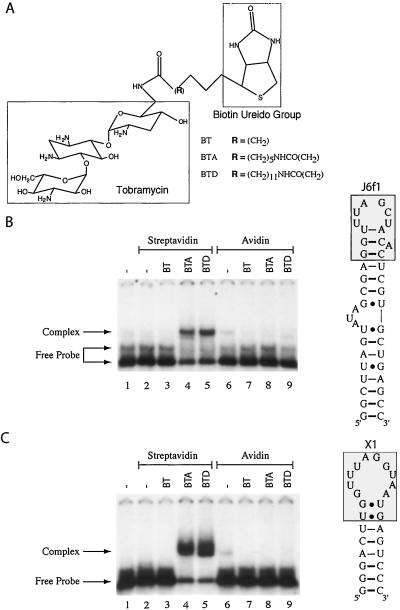Figure 1.
Formation of an RNA/protein complex mediated by a chemical inducer of dimerization. (A) Biotin/tobramycin CIDs used in this study. The nature of the chemical spacer for each CID is denoted (Bottom Right). BT, BTA, and BTD were purchased from Toronto Research Chemicals (Downsview, ON, Canada), and identity was confirmed by 1H-NMR and mass spectrometric analysis. (B) Specificity of RNA/protein complex mediated by CIDs. EMSAs were performed with 240 nM 32P-labeled J6f1 in the presence of 250 ng of streptavidin (1.7 μM) (lanes 2–5) or 250 ng (1.6 μM) of avidin (lanes 6–9). The presence of 10 μM BT, BTA, or BTD in the binding reaction is indicated (Top). Complexes were resolved on a 5% polyacrylamide gel (30/0.8; acrylamide/bisacrylamide) by electrophoresis in 2 × TGE buffer. Gels were dried and exposed to X-Omat x-ray film (Kodak). A schematic diagram of the J6f1 (19) tobramycin-binding RNA aptamer used in this study is presented (Right). The boxed shaded area highlights the tobramycin-binding pocket (16). (C) RNA/protein complex formation with X1 mediated by CIDs. Complexes were generated, resolved, and visualized as described for B. A schematic diagram of the X1 tobramycin-binding RNA aptamer (15) used in this study is presented. The boxed shaded area highlights the tobramycin-binding pocket (17).

